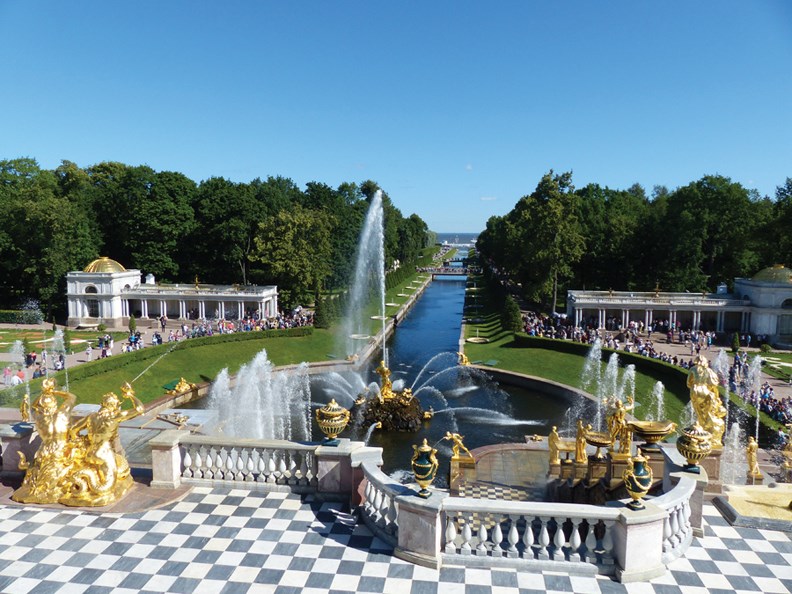A Baltic Cruise on HAL’s Eurodam facilitates a two-day visit of St. Petersburg. And ship excursions eliminate costly visas and expedite explorations.
“Peter the Great founded St. Petersburg in 1703, naming it for apostle Peter, his patron saint,” our first guide Tanya explains. “Providing crucial Baltic access, this new capital prospered despite harsh winters.” Travelling through the city, old suburbs and verdant countryside, our motor coach soon reaches Tsar Peter’s summer palace.
A walkway leads us past resplendent yellow, white-trimmed buildings. Pausing at a large church embellished with five golden domes, Tanya explains, “Often called Russia’s Versailles, Peterhof is a recognized World Heritage Site. Starting as a small family residence, the complex eventually encompassed gardens, upper and lower parks, palaces and even a forest.”
Inside, we pull on shoe covers to preserve lustrous parquet floors. Peter’s bedchamber and oak-paneled office seem surprisingly austere compared to other rooms. Elaborate gilt carvings border tiers of ballroom windows. Sixteen small circular paintings feature Ovid’s Metamorphoses and Virgil’s Aeneid. Painted among ceiling clouds, daughter Elizabeth ‘floats’ supremely above. In adjacent Chesma Hall, 12 large paintings celebrate Russia’s naval victory during the Russo-Turkish war.
Tanya recounts, “Peter began designing 30 palatial rooms in 1714. Daughter Elizabeth and grandson’s wife Catherine the Great expanded his efforts. As you see, they loved Western European style.”
From the black and white marble terrace, we gaze at the Grand Cascade’s magnificence. Rastrelli’s creation incorporates 64 fountains, 200 gilded statues, bas-reliefs and other ornamentation. In its central pond, a golden Samson wrestles a lion.
Strolling along the Marine Canal through lower gardens, we board a hydrofoil at the busy pier and within 30 minutes return to the city. There, swimmers bask along the beach fronting an early fortress defense against the Swedes. From inside the walls, soaring golden spires identify Peter and Paul Cathedral entombing Russian royalty from Tsar Peter to Alexander III. Disembarking along the Palace Embankment, we glimpse the fabled Winter Palace, home to Russian Royalty until 1917.
Breathtaking Resurrection of Christ Church concludes our day. Onion domes sparkle with blue, yellow and green tiles, two with gold. Inside, 7,500 square metres of mosaics drench walls and ceilings with brilliant, almost overpowering colour. Tile motifs frame radiant biblical scenes and figures. Shimmering in gold, silver and pastel enamels, the Holy Gates enclose the main altar.
“Alexander II was assassinated here in 1881, so its commonly called Church of Our Saviour on Spilled Blood. His son established this memorial on the very spot of his murder.” Tanya recounts. “Ransacked and used as a warehouse after the revolution, Russian artisans took 27 years to restore its former glory. Using early pictures and lithographs, even the stolen Holy Gates were recreated.”
Wondrous artwork fills our second day. “The Winter Palace and four connected buildings form the Hermitage, one of the world’s oldest museums,” grins guide Eva. “This famed museum contains over three million art pieces. Don’t worry! We’ll visit only the most notable.”
A marble spectacle in itself, the 18th-century Jordan Staircase leads upward to a lavish second floor ballroom. As a widow, Catherine the Great met eligible bachelors in smaller Pavilion Hall. A peacock clock represents a magnificent gift from one such suitor. Grand halls and ornate rooms exhibit 13th to 20th century European art. We spot Voltaire, eyes a-twinkle. Catherine commissioned Houdon to create this famed French philosopher, her beloved friend. One gallery encloses Tsar Peter’s original Rembrandts, collected while studying shipbuilding in Holland; others feature Catherine’s extensive masterpieces. Paintings by Degas, Renoir, Monet, Cezanne, Gauguin and Matisse represent the largest French art collection outside France.
Imperial St. Petersburg proves extraordinary.



